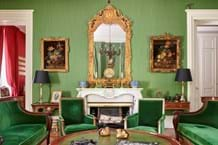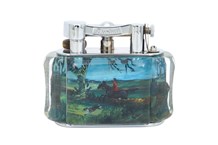It would be extremely doubtful that the late Peter Adams, linguist, teacher, bee-keeper and owner of the Thorne, would have considered the paperweight his most valuable possession, because his Georgian brick fronted house was furnished with a wealth of period brown furniture, but paperweights are so ardently pursued by American collectors (and a handful of UK buyers) that mega bucks are rountinely shelled out stateside for the finest 19th century French examples.
And this was one of those: the star cut base and upright bouquet (overlaid by cut panels of blue and white opaque glass) identifying it as a rare St Louis paperweight. But what really elevated it into the extraordinary was the silhouette of a running dog and hare in the opaque side panels. Interest from the United States gave way to leading English glass specialist David Fileman, who bid the winning £12,000 – the Sussex dealer confirming that he had bought the weight for stock.
While the surprise of this £200-300 estimated sleeper was the talk of the lunchtime recess, furniture dealers only had eyes for the fishbarrel shoot of fresh- to-market, single-source material due to begin.
The biggest catch of all was an Edwardian mahogany display cabinet, the whole festooned with floral, animal and ornamental marquetry. Such display cabinets have to be exceptional quality to clear £6000 if they are straightfronted, breakfront or even bowed in outline, but this example was scrolled and curved into a shape not unlike a kidney. It was also larger than average, at 8ft high by 5ft wide (2.44 x 1.52m) and in prisitine condition other than the loss of three spade toes. Consequently it was contested above the estimate of £3500-4500 by the trade, eventually falling to a Suffolk dealer at £9800.
So far as other highlights were concerned, unseen did not mean untouched.
A walnut and oysterwood sidetable, 2ft 7in wide by 211/2in deep (79 x 54cm) was basically William and Mary but durign the 19th century the top had been lifted, the drawer stuck and lined with velour to form a sort of unglazed jewellery cabinet. The flat X-stretcher had also been replaced, but there was no shortage of dealers wanting to restore the table to original glory, and it was chased to £6600 where £900-1200 had been expected. Old repairs and polishing, together with fading and further damage, reduced the prospects of a George I walnut tallboy of nonetheless outstanding construction and detail. Featuring canted and fluted corners to the upper section of three short, three long drawers, and a brushing slide to the three-drawer sunburst-inlaid base, the tallboy measured 5ft 10in high by 3ft 4in wide (1.77m x 1.01m) and sold to a man described evasively by the auctioneers as “a major trade buyer” at £7000.
Canterbury Auction Galleries,
May 15
Number of lots: 273
Number of lots sold: 254
Sale total: £184,000
Buyer’s premium: 10 per cent
Overlooked paperweight makes stunning £12,000
Furniture in country house is eclipsed by piece found in a drawer UK: PAPERWEIGHTS have not hit any sort of headlines in years and anyone outside the coterie of (mostly American) collectors may have assumed they had been relegated to the status of murder weapons in Thirties whodunits – but not so. One became the totally unexpected star of the contents of The Thorne, a country house at Bethsersden which were removed to the salerooms at Canterbury.




